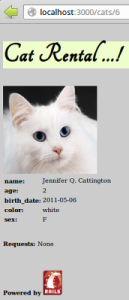Monday 7 October 2013— The main part of SedentaryRecord went pretty smoothly. I like my one-liner implementation of the has_many_through association better than the instructions' suggestion of writing a whole new query template; the TA Patrick pointed out that my version is inefficient (firing off two queries rather than one), but instead of writing the query-saving long version right away, I decided to try implementing validations first (one of the suggested extension ideas). That didn't go well at all; I spent a lot of time ineffectually hacking away at the problem but didn't even come up with anything worth committing!
Wednesday 9 October 2013— I did poorly on the assessment yesterday. There were eight SQL queries to write; the first five were trivial, but I bombed the last three because I'm a moron and didn't remember that the keyword for filtering aggregations was HAVING. I worked with William Ott on an ice-cream finder (which uses Google Maps APIs to print out directions to nearby ice-cream) and a Twitter client. Of course, it simply wouldn't do to write an ice-cream finder without using it to find ice-cream, so after class we took one of our program's suggestions and bought ice-cream at the Häagen-Dazs in the mall on Market and Fifth. Today I worked with David A.; we learned about routers and controllers.
Thursday 10 October 2013— Dear reader, suppose yet again that you're working on the great American dog-sharing site—loser! Sharing dogs is so last week; you should have predicted that by now, everyone who's anyone would be renting cats instead. That's why today Dean Yang and I used our prodigious knowledge of not just models, but also both views and controllers, to make a mock cat-rental site! It's like this: say you visit the URL for the page that displays all the cats. Your browser issues an HTTP GET request, which is handled by the Rails router: an instance of the CatsController is spawned, and its index method is called, which puts an array of Cat objects (instantiated by the ActiveRecord ORM from their representations in the database) in an instance variable, which is then made available to a process that uses a template to decide how to express the information about the cats in HTML, which is then sent back to your browser. Similar stuff happens to let you make a new cat, or edit an existing cat.
Sunday 13 October 2013— On Friday I worked with Nathan Holland again; we added users and authentication to the cat-rental site! It's like this: in the app/config directory of the source repository there lives a file named routes.rb, which which tells Rails what to do with requests! Like, routes.rb contains a line that says "get 'login', :to => 'sessions#new'", which means that if someone issues an HTTP GET request to /login at our application's domain, that what happens next is determined by the new method in the SessionsController. As it happens, all that does is send back the log-in form generated from the template at app/views/sessions/new.html.erb. When the user submits the form, a POST request is issued to /login, which gets routed to the create method in the SessionsController! That does a few things. First, it tries to find the user in the database using the supplied credentials (username and hash-of-password). If that doesn't work, it shovels a friendly incorrect-username-or-password message onto flash[:errors] and renders the log-in page again (including the message from the flash hash). But if the user was found, then it logs them in by setting their session token, storing their current-user status in an instance variable, shoveling a friendly "Logged in from #{location}" message onto flash[:messages] (the user's location can be determined using their IP and the Geocoder gem), and redirecting to the page with all the cats!
Having accomplished this feat, Nathan and I spent a lot of time trying to push the application to Heroku so that we could test things like how to handle a user being logged in on several devices at once, but Heroku dislikes SQLite, and various attempts at troubleshooting the issue all failed horribly.

Leave a Reply